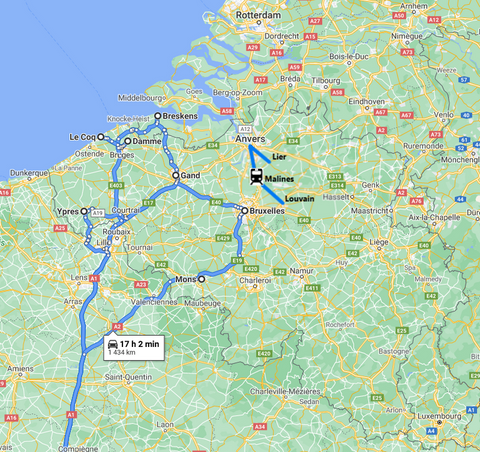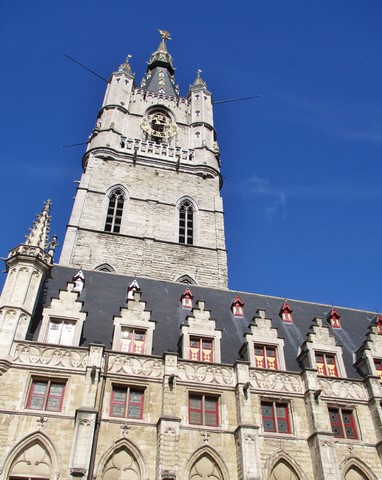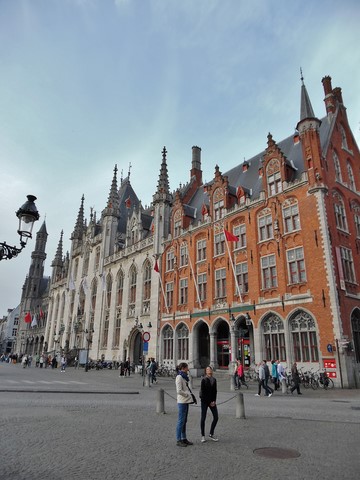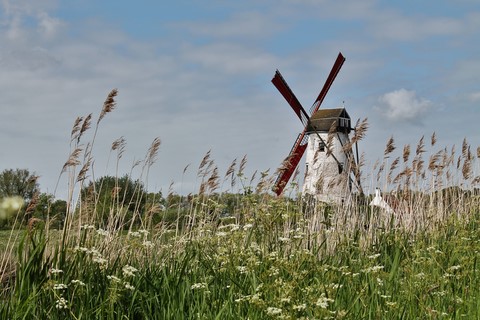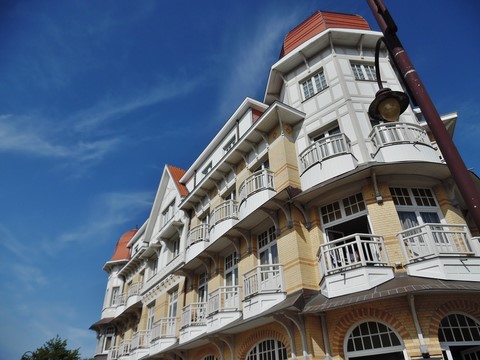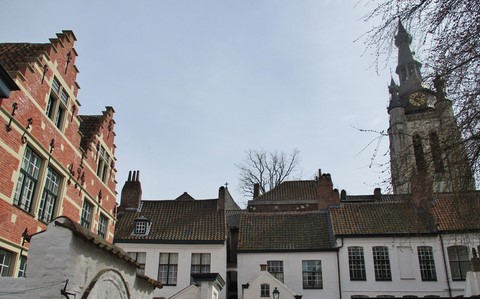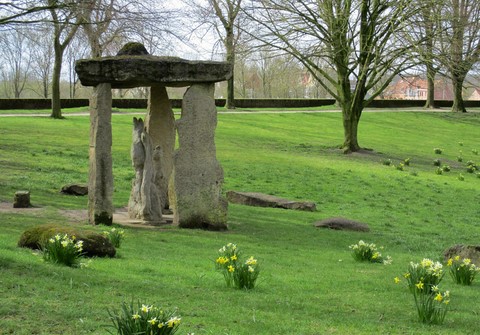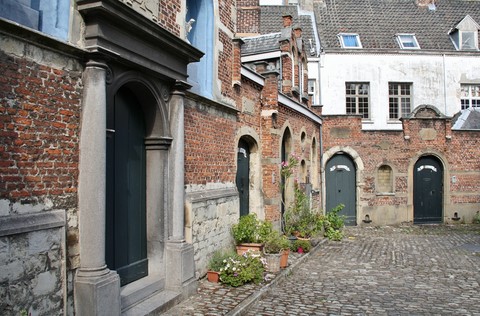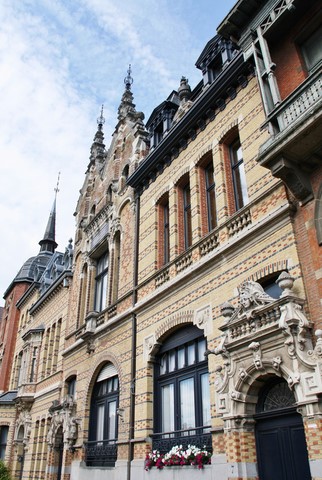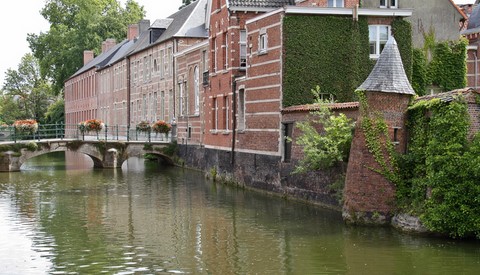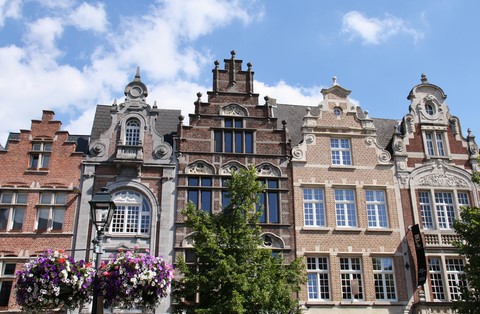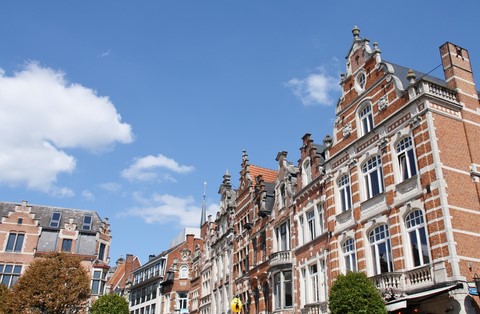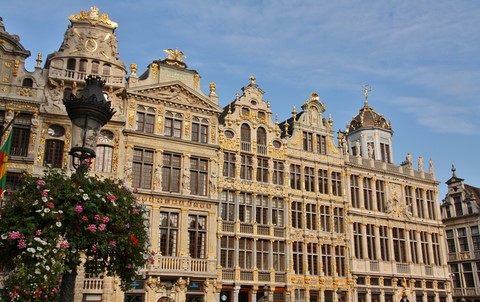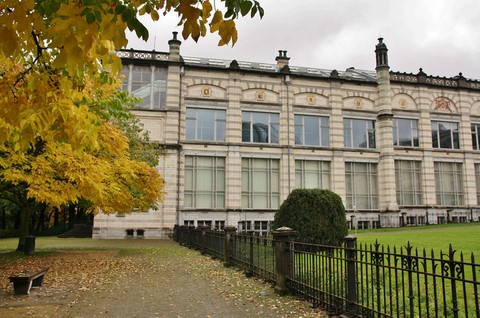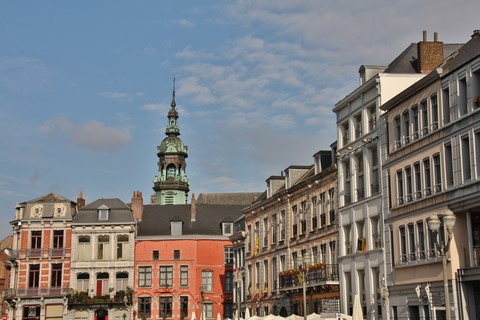Belgium
You can click on the map and on pictures to enlarge them
In 2015, we went to Belgium, plan that had been in the back of our minds for months. Indeed, given that J.R. had been living in the Paris region since 2013, that charming small country is easily accessible to him for a short stay. Besides, he had succumbed to the temptation twice on his own, and the memories he had reaffirmed our wish to go there together, and to fill out our list of visited countries in the process. So, we left to have an extended weekend in late May in the beautiful region of Flanders, from which we went on an excursion to the Netherlands, more specifically in Breskens and Sluis.
We notably visited two must-see cities filled with history that vie to outdo each other in beauty: Brugge and Ghent. We've been amazed by a green and very flowered countryside under the spring sun, where very typical barns, castles, abbeys run along, as well as dikes and canals. Some mills that stood the test of time rise majestically there. That is why we consider the term «flat country» is very reductionist. First, only the northern part of Belgium – mainly made of plains - is concerned. The southern part is hillier, even mountainous in some places. But above it all, it is likely to give a negative perception of those lands filled with beauty and character. But the Belgian people seem to put up with it, because they are very humble and have a great sense of humor and self-mockery, which does not alter in any way the pride in their origins. There, we met simple and hospitable people, warm and sincere smiles.
Then, we went to Brussels in mid-October for another extended weekend that ended in Mons, European Capital of Culture 2015. Sincerely, we liked the capital less than Brugge and Ghent, but it is much relative: it is undeniable that it pales in comparison with the two cities of the Flanders, but it is full of treasures, the most publicized is naturally its sumptuous Grand Place.
In April 2018, we spent a couple of days in Kortrijk in West Flanders. We also visited Ieper, just as charming, and returned to Ghent with happiness.
In July 2020, we went to Antwerp for five days by train; that superb city was also the point of departure to go to Leuven, Mechelen and Lier using the same mean of transportation. We had planned for a long time to travel that way in a foreign country: so, that was a major first. Our presence in a foreign country on its National Day was the other major first. Unfortunately, festivities were reduced because of the restrictions due to the Covid-19 pandemic. What a pity!
Besides, we were pleasantly surprised by the importance given to bikes in that country. They are very numerous, and cyclists are respected. In big cities, their omnipresence softens the atmosphere, and you can feel it in people’s mood and behavior, cooler, less stressed and less aggressive. Obviously, it is refreshing for locals and visitors.
In any case, those three short stays tempted us to go back there regularly, because even though it is a small country, Belgium is very rich and varied in many areas. Its regions all have their character and their history, sometimes tormented. That is why you can discover it in various steps over time.
East Flanders
The city of Charles V is an indisputable beauty which matches Brugge. They have in common their historic centers with cobbled lanes, their stepped gable brick façades and their canals, which gives them an undeniable charm. However, Ghent is a student city, so it is more lively, and besides less touristy. It is not a museum city like Brugge and consequently it is less popular. Yet, historical buildings and culture institutions abound. It has two medieval fortresses, churches and abbeys, beguinages and many museums. It is even more beautiful at night when its superb illuminated façades reflect on the smooth water of the canals. Its wide squares surrounded by typical lanes are sumptuous. Ghent is resolutely multicultural, modern and eclectic. You discover it the best on foot or by bike, as well as its surroundings. It tempts to stroll because even though it is very lively, you feel like lingering in every corner to enjoy the moment and immerse yourself in its atmosphere.
The Belfry, built in the 14th century, dominates the Historic Center (photo) with its height of 91 meters. Its carillon has 53 bells, the whole actuated by an impressive mechanism. On its base, the Sheet Market, which dates from the 15th century, was yet only completed in the 20th century. It is Late Gothic style. Nearby is the Royal Dutch Theater. You can see on its beautiful Renaissance façade the Goddess of Harmony as well as Apollo and the Muses. The Saint-Bavon Cathedral, in Brabant Gothic style, houses a Roman style crypt. Altars are numerous, but its main attraction remains the famous painting «The Mystic Lamb». It has other artworks, notably paintings and sculptures. Its tower is almost as high as the Belfry, above which it jutted out when it still had its spire. The Saint-Nicholas Church was erected in Scaldian Gothic style with blue stone from Tournai. It stores Baroque furniture. On the top of the Masons’ House, Moorish Dancers seem to jiggle gracefully. The Castle of Gerald the Devil is an amazing building from the 13th century in the city center. It houses nowadays the National Archives. The Herbs Quay and the Seeds Quay face each other around a canal, displaying their superb façades. According to us, it is the most beautiful place in town at night, when it is illuminated with a soft light that tempts to contemplation and dreamlike.
It is hard to miss the Gravensteen when you take a walk in the Patershol district. Like the Castle of Gerard the Devil, it is an imposing building located in the center of the city. Fortified castle from the 12th century with crenels and turrets, it houses an unusual collection of torture instruments. It is possible to walk on the enclosure wall and enjoy an unrestricted view of the city. The Alijn House is a set of nice houses with immaculate façades that houses the Museum of Flemish Popular Traditions, a miniature beguinage and a puppet theater. The Old Saint-Elisabeth Beguinage was founded in 1242 and destroyed in 1874. Its remains surround a pleasant little park: a church and red brick little houses which some walls were whitewashed. The captivating silence in that place is all the more enjoyable in the city center. The Rabot Towers are a 15th century small castle. Erected along the Lieve Canal, they were used as locks, which was for that time a real feat. In spite of their massive look, their pointed roofs give them a certain aesthetic.
In the De Zuid district, the SMAK (Municipal Museum of Contemporary Art) is a must-visit. We understand why it is the pride of the city. The most popular contemporary artistic movements are represented and prestigious exhibitions take place. Nearby, the MSK (Fine-Arts Museum) is very functional, in addition to its impeccable aestheticism. It includes among others an amphitheater and a library. The University Botanical Garden, one of the numerous green areas in Ghent, has a wide variety of plants. The Saint-Peter Abbey was built in the 17th century on a former Roman abbey church from the 7th century. The site includes ruins, as well as gardens and vineyards. Its Center of Arts offers many temporary exhibitions. The Small Beguinage Our Lady of Ter Hoyen was founded in the 13th century. Nowadays, it houses artists’ homes and workshops. Whitewashed walls contrast with the façades of red brick and brown brick buildings. In places, its lawns are carpeted in daffodils which bright yellow color brings life to that peaceful site. Finally, Glass Alley is the unusual place in the district, or even in town: it is covered with a glass dome, and there you can see prostitutes making lascivious eyes to you behind windows.
The Saint-Bavon Abbey, located in the Portus Ganda district, was founded in the 7th century. Charles V had it destroyed almost completely to have the Spanish Castle built. However, the former abbey church was built again. The Large Sint-Amandsberg Beguinage is the most recent of the three beguinages in town, since it was founded in 1874 when the Old Saint-Elisabeth Beguinage was destroyed, in order to welcome the beguines. It is the widest as well: it had among others convents, a church, a chapel and an infirmary. It was converted into a very nice residential city.
Citadelpark is a municipal park created in 1875 on the remains of the ancient Dutch Citadel. Indeed, you can see in places remains of casemates. It is very pleasant, and its tree diversity gives it a remarkable botanical richness. Its old bandstand is beautiful.
We stayed in the Maalte Chalet hotel, in the pleasant green setting of Maaltepark, located in the south-west entrance of the city. The very typical building is filled with an old-fashioned and very authentic charm. In the entrance hall stands an old piano. Inside our room stood antique armchairs, a chessboard and a bookcase with an old encyclopedia. We were surprised, especially since it was a 2 star hotel. We got a right warm welcome. The breakfast and the service were high quality. We also enjoyed the idyllic park, haven of peace with soft and varied colors which allowed us to disconnect from the city while we wandered.
West Flanders
The «Northern Venice» is often considered as the most beautiful and the most romantic city in the country. As soon as you enter its city center, you understand why. Strolling in the heart of its sumptuous medieval times setting is like traveling in time and is a real change of scenery. The numerous canals tangled up there give it a fairy atmosphere, especially at night, when it is adorned with a soft light under the dimmed lighting. A ride in boat will allow you to see it from a different perspective as you pass under its countless bridges filled with charm and to discover its secret gardens. Obviously, it is the victim of its own success during vacation, weekends and fairy days, and you see an almost permanent parade of pedestrians, cyclists and carriages. Nevertheless, it kept an authentic charm. Its historic and cultural buildings seem to have stood the test of time and the throes of mass tourism. People in Brugge are nice, helpful and cheerful. It adds to the impression of sweetness of life of the city. Contrary to Ghent, it is not a student city. So, it has not the same exuberant nightlife. Catering there is high quality. Obviously, the must-visit chocolate shops and lacework shops are numerous, as well as antique stores, curio shops and art galleries.
The Historic Center which is built around Grote Markt (photo) and the Burg, include naturally most of monuments. It is on the list of world heritage of UNESCO. It is full of museums, but be aware that they close rather soon. The Belfry rises on Grote Markt to dominate the city with its 83 meters. Its carillon has 47 bells. Climbing it is physical, but it’s worth because the panoramic view of Brugge is unique. The Burg is the other must-visit square in the city. Its City Hall from the 14th century is a Flemish-Brabant architectural treasure. It is gabled with turrets and beautiful coat of arms decorate the façade on which are numerous high and narrow windows. Feel free to enter and visit the Gothic Room adorned with sumptuous frescoes from the late 19th century. Nearby, the magnificent Neo-Gothic style Saint-Sang Basilica, houses the Roman style Saint-Basile Chapel. Also on the Burg, Franc de Bruges is a Classic style building which includes the Courthouse and a sumptuous Renaissance style room. Like the capital, Brugge has its own Chocolate Museum. Nevertheless, its Fries Museum is just as instructive in addition to being playful.
The Beguinage , real village in the city, enjoys an incomparable bucolic setting. Overall, it is quieter than the city center but it draws crowds almost as much. Like frozen in time, it takes you to a bygone era from centuries ago. Its traditional whitewashed façades give it a quite particular character you only can find in Northern Europe. Its little garden, haven of greenery pleasantly shaded is absolutely peaceful and quiet. The romance and the dreamlike coming from Lake of Love Park and its superb wooded paths essentially planted with poplars will certainly seduce you.
East of the city, Saint-Anne – its oldest district – is located between the Historic Center and the Gand-Ostende Canal, along which run preserved mills. There are four, the only saved among those built along the ramparts from the 13th century to the 19th century. It is an under-visited residential area, which earned him the nickname of «forgotten corner». But its peace is precisely appreciable and its atmosphere is conductive to long walks far from the beaten tracks of tourism. Nevertheless, it includes some attractive museums and places of worship, among others the Lace Center and the English Convent.
West of the city, 't Zand, yet lively, is lesser known by most of visitors. Indeed, they come there in the beginning of their stay to use the services of the Tourism Office, and then they leave it in favor of the Historic Center and the Beguinage. It is especially famous for its wide square lined with cafés and restaurants and its theater: the Concertgebouw.
Located in verdant polders a few kilometers North-West of Brugge, Damme is a small picturesque small town. It was previously on the edge of the former Zwin Estuary and linked to the North Sea by a canal. It was an outer-harbor of the «Northern Venice» and developed simultaneously with it. It started to decline as a result of the Zwin sanding. In spite of its small size, it has many monuments: the Gothic style Town Hall on the Market Square, the Saint-Jean Hospital built in the 13th century, the Big Star House which now houses the Tourism Office, the Uilenspiegel Museum and Our Lady Church. To those are added the Ancient Herring Market, the ancient ramparts, the windmill (photo), and old barns with an old-fashioned charm. The setting there is natural and enchanting. Verdant polders and fruit trees are next to fields of flowers and natural creeks. Along the main canal, a paddle boat slides peacefully through the water.
Let us face the truth: the Belgian coast is excessively urbanized. It stretches on almost 70 kilometers, and it is concreted almost in its entirety. Seaside resorts run along, linked by a tramway which serves each one on no less than 70 stations! Rather ugly modern buildings swallowed up the few left style buildings. Fortunately, a nature reserve extends near each borderline (French and Dutch). They allow you to enjoy preserved coastal areas.
Besides, two seaside resorts stand out for having kept an undeniable authenticity: Knokke and De Haan. We visited the latter on a beautiful sunny Sunday. And we must admit we were enchanted. It seems that time stopped in the 1930's there. Villas proudly rise among flowered and verdant gardens, witnesses of an era that seems to remain in that enchanting coastal small town. The site is classified and makes room among others to Anglo-Norman buildings like the Grand Hotel Belle Vue, or Art Deco style buildings like Hotel Astoria. The tramway station displays its beautiful Belle Époque façade.
Located in Westhoek, border region with the North of France, Kortrijk was founded in the Roman period. Riddled with many invasions, its peace and its relaxed rhythm of life contrasts with its tormented history. There are many medieval buildings, for the city flourished at that time thanks to the flax industry. It is famous for its museums, notably the Museum of Lys and flax, and Kortrijk 1302, devoted to the Battle of the Golden Spurs in 1302 which plays an important role in the country’s history. Its arts centers are equally notable. Fashion is not forgotten and chic boutiques are many. Finally, it knows how to emerge from its happy lethargy on the occasion of well attended popular festivities.
The Late Gothic style City Hall from the 16th century is provided with beautiful stained-glass windows and sumptuous murals. It is located on Grote Markt, which we unfortunately could not visit because our stay coincided with the Easter Carnival which occupied the whole square. Nevertheless, we could admire the top of its Belfry from the 13th century with a statue of Mercury on, and provided with a 48 bells carillon.
We have been enchanted by the Saint-Elisabeth Beguinage (photo), real village within the city. UNESCO world heritage site, it includes about forty small houses full of charm, and its chapel houses an organ from the 17th century. It has also an interactive museum. It is the most beautiful beguinage we have ever visited.
We cannot help comparing it to Baggaertshof, a stone's throw away from there, where some small houses and a chapel are surrounded by the green setting of a very varied botanical garden.
The Saint-Martin Church and the Saint-Anne Chapel include many artworks, notably very valuable paintings. They have been restored or even rebuilt over centuries, the same as Our-Lady Church and the Chapel of Counts that include among other masterpieces the sumptuous Statue of Saint-Catherine.
The imposing outlines of the Broel Towers rise on both sides of the Lys River just in front of the bridge across it. They are a testimony of the past of Kortrijk as a fortified city.
In the heart of the Lys River, the Buda Island is the nerve center of contemporary art in Kortrijk. Various exhibitions and workshops take place there. A recreational park allows many visitors to re-energize, and to enjoy a real beach atmosphere during the warm seasons.
Also located in the Westhoek region, Ieper flourished in the Middle Age thanks to cloth manufacture, as did Brugge and Ghent. Ravaged during the Great War, it was rebuilt exactly as it was before with a remarkable thoroughness, so much that you could think all the buildings are original if you are not an architecture expert. The Gothic style Saint-Martin Cathedral is the perfect example with the breathtaking architectural details of its façade, the same as the sumptuous and imposing Sheet Market on Grote Markt, where Baroque, Classical or Neo-Classical style buildings strung out. The 70 meters high Neo-Flemish style Belfry overlooks that architectural ensemble which beauty is only equaled by its hugeness. It includes a 49 bells carillon.
The In Flanders Fields Museum brings back the painful memories of World War One - from which the city suffered much - thanks to a collection of pieces and heart wrenching testimonies. As for the Hospice Belle Museum - former hospice as the name suggests - it includes many valuable pieces, among which the most remarkable is a 15th century painting of the Blessed Virgin.
Ramparts are very well preserved and are worth a visit. The latter is 2.6 kilometers long (photo), from the casemates to the 19th century powder magazine, and crosses places filled with history which testify the turbulent past of the small city.
Province of Antwerp
Historic Center and surroundings
We went to that magnificent city by train, ending up in Antwerp-Central Station, which is classified as a UNESCO World Heritage Site, and rightly considered as one of the most beautiful in the world. Moreover, it is very long and has four floors. Its Neo-Baroque architecture is extraordinary, outside and above all inside, where its restored hall is a real jewel. It is covered with an impressive dome. Besides, the long viaduct of elevated railways is also a masterpiece. It is in front of Diamond District. Indeed, Antwerp is the global hub of diamond trade. Many jewelries and workshops run along there. Behind the station stretches the Zoological Park. The big entrance proudly displays its gates and pillars embellished with mosaics and covered with statutes of animals, the whole in a nice Art Deco style.
To reach the Historic Center from the Antwerp-Central Station, we took the Meir, a major pedestrian and cycle path lined by sumptuous edifices, where shops, bars and restaurants run along. Just before, we swooned over the buildings located between the statues of the painters David Teniers and Antoon van Dyck: a mix Neo-Gothic and Art Nouveau styles. Opulent and imposing, they bear witness to the wealth of the city. Sculptures and moldings are splendid, as well as the statues perched on top of the roofs. The Meir itself has an extraordinary architecture, notably the ancient Royal Palace in Rococo style, and the Stadsfeestzaal, big shopping mall housed in a ballroom. The interior decoration is as much impressive with its glass roofs and its gilding. We also took beautiful passageways in various galleries. We got into small adjacent streets to admire nice murals. In sight proudly rises Boerentoren (Farmers’ Tower), a big Art Deco building, which was the first skyscraper in Europe, and the highest in the continent until the 1950’s.
Once we reached the Historic Center, we crossed Groenplaats, rectangular square which is the heart of the city, then we went to the Hotel Postiljon, superb medieval building, where we stayed for the whole journey. It is located right next to the Onze-Lieve-Vrouwekathedraal, splendid cathedral in Brabant Gothic style. Unfortunately, it was under construction: its northern tower, 123 meters high (the highest in Benelux), which constitutes the belfry with its clock and its carillon, was surrounded by impressive scaffolding with a highly sophisticated system of sliding elevator. Nearby, Grote Markt stretches in an irregular shape that makes it singular. Houses from the 16th and 17th centuries display their traditional stepped gables. The architecture of the imposing City Hall is a mix of Flemish Gothic and Italian Renaissance. On top of Brabo Fountain rises the statue of Silvius Brabo, a historical character in Antwerp.
Then, we reached the Steenplein, a long concrete platform that overhangs the Escaut and leads to a restaurant. Benches run along there, and you can sit down to admire the large river and attend the ceaseless ballet of the boats that offer a visit of the port. We continued the walk along the bank to visit the Steen, the oldest building in Antwerp, which is part of a fortified castle from the early 13th century located on the right bank of the river. Unfortunately, it was also under construction and inaccessible. Opposite rises the Vleeshuis Museum (House of Meat), a red brick Late Gothic building that housed the Antwerp Butchers’ Guild in the Middle Age. Nowadays, it is a museum dedicated to 600 years of musical life in Antwerp and in Netherlands.
Religious buildings are not left, and we went to admire notably the Saint-Paul Church and above all the Church of Saint-Charles Borromeo and its superb Baroque façade on Hendrik Conscience Square (Hendrik Conscienceplein), which is isolated and much pleasant. As for the Saint-Nicholas Chapel, it houses a puppet theater and enjoys a small interior courtyard filled with charm and lined with old buildings with nice façades where stands a restaurant. Not far, we went to swoon over the beautiful Handelsbeurs, ancient Trade Exchange converted into a public space: the interior in Neo-Gothic style embellished with a floral landscape is sumptuous. A superb metal frame props up the stone, and a splendid glass roof covers the building. Walls and ceilings are decorated with paintings, finely worked paneling and stained glass windows.
North of the Antwerp-Central Station and the Zoological Park, we crossed the Chinese District, which is small but exotic. The entrance gate, much colored, is superb. Then, we visited the Beguine Convent (photo): there you find the traditional red brick and the walls covered with white lime, which beautifully contrast with the greenery of the orchard and the lawn. The Saint-Catherine Church rises among houses, which discreetly run along behind brick fences. Obviously, you can feel that peace and that serenity likely to that kind of place that we never get tired of. The rare bikes leaning on walls add some charm. We lingered there to enjoy that unique atmosphere.
On the last day, we decided to take the Saint-Anne Tunnel, which dates from the 1930’s and allows you to reach the district that bears the same name on the opposite bank of the Escaut. The varnished wood period escalators offer a real travel in time! In the 572 meters long underground, period photographs are presented, notably pictures of the visit from well-known figures on the site, or simply from the different steps of the construction. Once you reached the opposite bank, you can enjoy a nice global view of the city center from the distance.
On the gastronomy front, we ate well in Antwerp, with a special mention to the restaurant 7 Schaken. There, they serve a very good Flemish beef stew, and excellent pork cheeks in Brabant style with beer sauce. The old-fashioned inner decoration is much pleasant and typical. We even tasted the local liqueur: the Antwerp elixir, based with 32 plants and livened up with spices. It is rather syrupy and much flavorful.
Other districts
The Docks District (Het Eilandje), very well refurbished, immediately appealed to us. It is the modern district in the city, and bars and restaurants are numerous. It is hard to miss the Museum aan de Stroom, a big museum that rises in front of the Bonapartedok basin. Made of red sandstone in avant-gardist architecture, it represents containers stacked on one another, and the large undulating bay windows form vertical waves. Just behind stands the Willemdok basin, where some boats are moored to the quays, notably nice period sailboats. We were lucky to attend the starting of Londenbrug, a lift bridge with an impressive mechanism. East of that one, Park Spoor Noord is a wide area fitted out on a former sorting station. There are kindergartens, a skate and BMX park, water gardens, and a covered hall complemented with a terrace. North of the lift bridge, we strolled on a dirt path along the Kattendijkdok basin, where terraces and bars fitted out in row warehouses with gables decorated with perforated wrought metal panels run along. Decorations are much varied and offbeat. Deckchairs, folding chairs, wrought iron chairs, shrubs, fishing nets… nothing was forgotten. But the most unusual thing is the old yellow van with an old-fashioned charm perched on a container. Three superb murals stretch at the beginning of the path, as a way of welcoming and getting us in the mood. The place creates much enjoyable carefree attitude and sweetness of life. We could not resist the temptation to sip a beer in Bar Paniek. As we continued, we passed in front of the amazing Nieuw Havenhuis building, where a sculpture that represents a gigantic diamond covers the roof of the former fire station: a surprising mix of old and modern.Then, we headed west, taking a bridge over the Royers lock (Royerssluis) to reach Noordkastel, ancient fortress built on that place to protect the Oosterweel extinct polder village. Now, only a small part of the ramparts remains, as well as a kind of wild green and wooded space by the Escaut river: it faces Sint Annastrand, the small beach of Saint-Anne district. Besides, we could see swimmers on the opposite bank. Old abandoned wooden piers bring the place a touch of nostalgia and an old-fashioned charm. On our way back, we passed in front of Droogdokkenpark, an urban green space landscaped by the river where visitors come and have a good time. After that, we went to see the Red Star Line Museum, which traces the history of that company that would transport by sea the numerous migrants who fled from various misfortunes in Europe to reach the U.S.A. - notably New-York – and try to make their American dream come true. At least they aspired to a better life. Let us keep in mind that Antwerp is one of the largest ports in Europe. Finally, we went to settle comfortably in Jardim Antwerpen, a very nice bar by the Escaut where some sand was laid on the floor. You can take off your shoes and sip a drink while enjoying the pleasant contact of the sand under your feet. The atmosphere is young and cheerful.
South of the center, Zuid, the trendy neighborhood, is really not popular for tourists. Taking a walk there is much pleasant and we did not meet many people by day. We were amazed by the architecture of the M HKA (Museum of Contemporary Art), which has the originality of having been housed in a former grain silo, and that of the New Courthouse (Nieuw Gerechtshof) and its resolutely avant-gardist style that completely clashes with other buildings: metal sails with angular outlines rise on its roof. The Saint-Michael-et-Saint-Peter Church, which has no less than three aisles, enjoys a nice Neo-Roman and Neo-Byzantine architecture. Still, Art Nouveau buildings are well and truly the ones that stand out in that district: the House of the People displays its façade adorned with sculptures and mosaics, as well as its large horseshoe arch bay window. Nevertheless, the most impressive is the Five Continents Building: you can see from the distance the prow of a boat at the corner of the second floor that serves as a balcony, covered with a circular loggia with its beautiful glass canopy. It is simply amazing for its daring and its creativity! Opposite, you can admire the bow-windows in a row that form a superb perspective.
We got off at Anvers-Berchem station to visit the extraordinary Zurenborg district, far away from the beaten track of tourism as well. It is located south-east of the center. We swooned over huge and magnificent buildings (mainly private mansions) that proudly display their Art Nouveau façades, testimony of the greatness and the splendor of the Belle Époque, notably in Cogels-Osylei street (photo), Transvaalstraat and Waterloostraat. Neo-Classical and Eclectic styles also have their place there, thus composing a breathtaking architectural ensemble. In Waterloostraat, the «Battle of Waterloo» house, which therefore gave the street its name, is particularly worth seeing, as well as the «Les mouettes» house. At the crossroads with General van Merlenstraat, four houses face each other on either side: the architecture is similar and each one deals with the theme of a season of the year with a different color. Belgium is definitely THE country of Art Nouveau!
Anvers is part of our favorite cities. To have direct access to the section, click here
Located nearly 20 kilometers away from Antwerp, at the confluent of the Grote Nete and the Kleine Nete, it is nicknamed «small Brugge». It necessarily suffers from the comparison with its big sister, but it is nevertheless worth to linger in.
Antwerp Street, very pleasant with its shops and its loudspeakers that play music, links the station to the beautiful Grote Markt, rather wide and which originality is its triangular shape. Further, we admired the Saint-Gommaire Collegial Church, in Flamboyant Gothic style, and then the nice buildings that line the Kleine Nete (photo). We walked along the latter, thus moving away from the center to reach a woody and grassy area, where a gray heron peacefully rejuvenated. At the end the path stands the Spui, former lock keeper house built in the early 16th century. Two locks buildings were erected there: the Groot Spui (big lock building), and the Klein Spui (small lock building) that no longer exists. Now, it is used as an exhibition room.
We were surprised to find that small town rather lively, which made the visit all the more enjoyable. We admired for a long time the Zimmer Tower and its superb Centennial Clock, real masterpiece and iconic building of Lier. Inevitably, we thought about the Astronomical Clock in Prague, relatively speaking. The Beguinage is small but much pleasant. Above its entrance gate is the Statue of Saint-Begge, patron of beguines.
We ate at one of the restaurants located on Grote Markt, where I tasted an excellent local beer to accompany the meal, the best of that trip according to me. Then, we went to a patisserie to taste another local specialty: the Liers vlaaike: it is a small round cake based on candy syrup, speculoos and spices. It is good and nourishing! That was a good way to conclude that very enjoyable visit.
Mechelen
That nice city of more than 86 000 residents is located nearly 30 kilometers south of Antwerp. The architecture there is rich and the atmosphere is much pleasant. We visited it on National Day.
We started with the must-see Grote Markt, which is aptly named, for it is very wide. The Town Hall includes the Sheet Market and the Grand Council Palace in Late Gothic style. Nearby, we admired the Saint-Rombaut Cathedral: its imposing tower is 97 meters high and it has two carillons, each one with 49 bells. In front of that superb building, we attended a small military parade with a marching band, then a few minutes later, the passage of fighter aircrafts in the Mechelen sky.
The city enjoys two beguinages. We started with the Large Beguinage. It is different from most of others, for it is not a closed space. It houses a brewery that dates from the 14th century and that is still in operation. It is home to a hotel at the disposal of visitors. Then, we went to Kazerne Dossin, a place filled with a dark side of history: it is the starting point of deportation of Jews, Romani and Sinti. A wagon is even exhibited in front of the building. The Small Beguinage is very pleasant. Its wide and picturesque orchard has many apple trees which branches crumble under the weight of numerous fruits.
Finally, we got further from the center to walk along the Dyle River, which crosses the city. The walk was much enjoyable: some nice boats were moored to the quays, and small rowing boats floated peacefully along the red brick walls. At the Haverwerf (Oat Quay), we passed in front of three colored row houses in Medieval style. They compete in a beauty with a singular and old-fashioned charm. The leftmost dates from the 16th century: it is Saint-Joseph House, in Baroque style. The one in the middle, the Devil’s House, displays its superb Renaissance architecture. The rightmost, on the corner, is Paradise House: in Brabant Gothic style, it dates from the 16th century. Its tympanum depicts the scene of the flight of Adam and Eve driven out of the Garden of Eden.
Flemish Brabant
Leuven
Leuven is a university city of more than 100 000 inhabitants. Young and dynamic, it enjoys moreover an extraordinary architecture. It houses the head office of Anheuser-Busch InBev, bigger brewery in the world, which makes it the national capital of beer.
The first building we admired after we left the station is the Seminary Chapel Leo XIII, in Brabant Gothic style, made of red brick with a small inner courtyard. Then, we lingered in the Large Beguinage, which is aptly named since it is the widest in the country (7 acres). It is included in the UNESCO World Heritage List. Far from the center, it is crossed by small canals that give it additional attraction, just as its wells, fountains and statues. Most of its buildings have mullioned windows. We took the time to visit it and immerse ourselves in its peaceful atmosphere.
Then, we headed for the center taking Naamsestraat, a long straight street lined with colleges and other educational institutions, some of which are private with religious tradition. The American College was built in 1857 to train Belgian priests and seminarians who were taken on a job of missionary in the U.S.A. Later, it became a university residence for American seminarians who worked in the Leuven Catholic University, for the seminary ceased its operations in 2011. The Van Dalecollege houses a chapel that dates from 1571. The Former Arras Secondary School, which is adjacent to the University of Economy, was founded in 1508 for disadvantaged schoolchildren. It is now home to the International Relations Office. In its inner courtyard, you can admire De Kangxi-Verbiest hemelglobe, a metal sculpture that represents a globe near a superb polished glass old-fashioned veranda. As you walk on, you reach Sint-Donatus Park, set in its lush greenery, where ruins rise.
After that, we admired the beautiful façade of the Leuven Catholic University in the same street, before we reach Grote Markt. Surprisingly, it is not very wide, but the architecture there has a breathtaking beauty, especially the Town Hall in Flamboyant Gothic style: a real masterpiece! Its jagged façade displays a multitude of statues embedded in niches. You enter its small inner courtyard by way of the Tourism Office. Opposite rises the sumptuous Saint-Peter’s Church, in Branbant Gothic style.
Not far extends the magnificent Old Market Square (Oude Markt) (photo). More than forty cafés and restaurants run along there in an almost perfect alignment, so much that the place inherited the symbolic name of «longest bar in Europe». Leuven has almost two hundred restaurants and cafés in all, which places it in first position in Flanders.
The Saint-Gertrude’s Church, Benedictine abbey founded in the very early 13th century, can be spotted from a distance thanks to its imposing 71 meters high spire. It enjoys a superb cloister with a very pleasant atmosphere. Nearby, the Small Beguinage was founded in the second half of the 13th century. Some houses were destroyed over time, as well as the church and the entrance gate. In the other hand, the part that remains was remarkably restored.
We ended with the University Library and its belfry that overlooks the roofs of the city and houses the biggest carillon in Flanders with 63 bells. In Neo-Renaissance style, it stands in front of a much extended square, where rises a funny sculpture of a giant green-bottled fly pinned on top of a just as giant needle.
Brussels
The «Capital of Europe», cosmopolitan and welcoming, makes part of the cities that cannot be missed. People come from every corner of the Old Continent – sometimes of the world – to visit it and immerse themselves in its unique atmosphere. Multicultural, multilingual, its extraordinary diversity is undeniable. Its Historic Center, which is built around Grote Markt - with a remarkable architectural richness – abounds with other must-sees like the legendary Manneken-Pis, the Saint-Michel Cathedral, the Saint-Hubert Galleries... However, the other districts also worth the visit and enjoy as well a certain animation, given that the former inner suburbs of the cities are very wide. If you are interested in architecture and if you are not indifferent to the opulent and unbridled curves of Art Nouveau, be aware that Brussels and its outskirts include many buildings in that style, notably in Ixelles and Saint-Gilles, where stands the Horta Museum dedicated to Victor Horta, one of the undisputed master of that movement. Green areas are not left behind, with parks and gardens, and above all a forest at the edge of the city. Obviously, chocolate shops and estaminets or breweries where beer flows abundantly are numerous. Also rooted in the country's heritage, the comic strip is honored in the whole city, as well in dedicated establishments like the Belgian Center of Comic Strip as on the numerous murals dispersed in all districts.
Historic Center and surroundings
Classified UNESCO World Heritage, Grote Markt (photo) is a real architectural gem. It displays its façades that rise proudly to shape a perfect rectangle within which an admiring and enthusiastic crowd come to stream in close rows at peak times. The ensemble has a remarkable harmony. The Town Hall, built in the 15th century in Gothic style in three stages, is the main building. Its stunning 96 meters spire seems to overlook the town and is used as a landmark. Its façade has no less than 150 statues! Feel free to cross the carriage entrance to get into its beautiful courtyard. Another Gothic building, the King's House, includes the Brussels City Museum, which traces its history through many artworks, scale models and others. It also houses the extensive collection of the Manneken-Pis' costumes. The other buildings of the square - notably the Corporations House - are a harmonious mix of Italian Baroque and Brabant-Flemish architecture.
Nearby, beautiful medieval streets and alleys get tangled up to shape the «Îlot Sacré», classified UNESCO World Heritage. Stepped gable brick façades multiply to the delight of marveled visitors. Generally, there are many cafés and restaurants in the very typical small streets of that district with an old trading history.
In the close surroundings, you will find the Manneken-Pis, famous bronze statuette that needs no introduction. Maybe you will be surprised by its small size: it is hardly more than 50 centimeters high. Iconic sculpture of the city, it is sometimes disguised and the water in the fountain is even replaced by beer! However, few people know its female version Jeanneke-Pis which stands in a small dead-end street on the other side of Grote Markt, and even less its canine version, the Zinneke-Pis that you will meet in the Saint-Géry district.
The Cocoa and Chocolate Museum – renamed Choco-story Brussels – will reveal you all the secrets of chocolate manufacturing and origins, all that in an old-fashioned setting. Obviously, demonstrations and tastings are also part of the program to the greatest delight of taste buds. On a different register, the Costume and Lace Museum is worth a visit as well.
The Saint-Hubert Royal Galleries, covered with a splendid glass roof, house on two floors theaters, shops and cafés, the whole in a remarkable Renaissance style.
The Saint-Nicolas Church, built between the 11th and the 12th century, honors the patron of merchants. It is modest size, so that it seems to mix with the old houses placed by its side. Nearby stands the Stock Exchange, imposing building from the late 19th century which columns remind the Greek architecture.
In the Monnaie district, the Monnaie Royal Theater displays its Neo-Classical façade. Inside, a beautiful crimson and golden decoration surrounds the stage where very famous shows take place. Nearby rise the towers in Brabant Gothic style of the Saint-Michel-et-Sainte-Gudule Cathedral, built in the 13th century on the remains of a Roman Church, as evidenced by the crypt. Its stained glass of the «Judgment Day» is sumptuous. Not far stands the Belgian Center of Comic Strip. It is an Art Nouveau style building from the early 20th century we owe the famous Victor Horta and its so particular style. The history of the 9th Art is traced, and the Belgian Comic Strip is naturally honored, especially Hergé and Tintin. The great library contains a priceless collection. The center also houses nice scale models.
The Sainte-Catherine district was built on the former basins of the city. The place is now full of restaurants specialized in fish. However, there are still some old houses that enable it to keep its character, as well as its church, harmonious mix of Renaissance, Roman and Gothic influences.
Saint-Géry is one of the liveliest districts, with its numerous trendy bars. Its Covered Market is Flemish Neo-Renaissance style. Nearby, the Rue des Riches-Claires and its surroundings take you to medieval times. The Church Our-Lady of Riches Claires, in Flemish Baroque style, is a masterpiece. Finally, you will meet there with amusement Zinneke-Pis, canine version of the Manneken-Pis mentioned above.
Not far, Dansaert has become lately the district of young innovative fashion designers after it sank into oblivion. Cafés are numerous, as well as very eclectic restaurants and art galleries.
The Place Royale, the Place du Musée, Brussels Park and the Rue Royale make up the Royal District, a beautiful Neo-Classical ensemble. It was built on the ashes of the sumptuous Palais de Bruxelles, which was built in the 11th and the 12th century, and which burnt in the 18th century. Not far, the Mont des Arts, with its impressive finely-worked stairs, seems to link that district to Old Town district. Its gardens and its water jets give it a very pleasant atmosphere. Do not miss on observing the details of the clock with carillons supported by its arch. As the name suggests, cultural institutions are represented there, among others the Fine Arts Royal Museum, the Belvue Museum, and the Musical Instruments Museum, superb Art Nouveau style building (former «Old England» shop from Victor Horta).
The Marolles popular district is especially famous for its Sunday flea market always very bustling. The Hal Gate and its impressive tower, which offers a panoramic view of the city, date from the 15th century. Those are the last remains of old Brussels fortifications. Now, they house a museum and temporary exhibitions.
The Sablons stylish district has many restaurants, chocolate shops, antique stores and art galleries. The Grand-Sablon enjoys nice houses built from the 16th century to the 19th century that gives it an asserted character and an old-fashioned charm. Its main attraction is naturally the antique market that draws crowds every weekend. It is worth to linger in the Petit-Sablon Square. That Neo-Renaissance style garden includes many statues, notably the ones on the wrought iron railing that defines the square.
In the European District, the European Parliament divides the inhabitants of Brussels: some see a modern architecture masterpiece in it, others see an eyesore that spoils the panorama. The visitor center (Parlementarium) offers original and fun exhibitions, notably a map of Europe in 3D. The contrast with Leopold Park (photo), much preserved haven of greenery created in the mid 19th century in the best tradition of landscape gardens, is striking. As for it, the wide Parc du Cinquantenaire dates from the late 19th century. Its wide lawns are much appreciated as soon as the sun comes out. It includes three remarkable museums: the 50th Anniversary Museum, the Museum of Army and Military History, and Autoworld.
You will see the Atomium from a distance as you join the Heysel district and the park with the same name. Grandiose project aimed at building a frame that represents an iron crystal molecule enlarged 165 billion times, it is part of the must-visits in the city. The inside can be visited and you can enjoy an unrestricted view of the city from its highest sphere. Various exhibitions take place there. Finally, do not hesitate to make a stop at the Miniature Europe and to bring eventually your children. It is both a very original and a very fun way to learn about the Old Continent.
Hainaut
Contrary to some cities in Belgium, the Mons Belfry is not located in Grote Markt, but within a stone's throw of there on top of a small hill, which increases its dominance. To get to it, we took a detour entering small streets where beautiful trompe-l'oeil murals picture scenes of «films noirs» from the 1950's, to reach the pleasant flowered Saint-Germain Square which has a decorative bowl. From there, you can see it overlooking the town from the top of its 87 meters. Built in the 18th century in Baroque style, it is gabled with onion-shaped domes that add to its beauty. Its carillon includes 49 bells. It is surrounded by verdant and wooded gardens.
The Sainte-Waudru Collegiate Church makes part of the monuments in town that worth a visit. Built from the 15th century to the 17th century, we owe its sumptuous alabaster decoration to Jacques du Broeucq, figure in the Renaissance in Northern Europe. It houses beautiful silversmith collections, sculptures, paintings and manuscripts.
Mons has very interesting museums: the François Duesberg Decorative Arts Museum will impress you with the richness of its collections, notably its incomparable collection of clocks. Various bronze artifacts, porcelain and silversmith are not forgotten. The Natural History Museum is distinguished especially in the field of zoology, introducing species from all around the world, even though most of them come from Europe. The BAM (Fine Arts Museum), the Military History Museum and the Mons Memorial Museum, open in 2015 on the occasion of «Mons 2015 – European Capital of Culture» worth a visit as well.
Published on November, 23rd 2016
Modified on October, 7th 2018
and March, 22nd 2021



